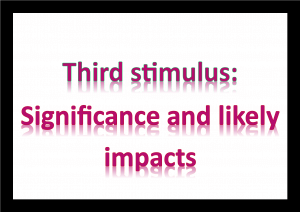Finance Minister Ms Nirmala Sitharaman announced a third booster package to the slowdown hit economy. The package covers two critical sectors – the export sector and the housing sector. For those two sectors, the government aims to make a spending of around Rs 60000 crores. A portion of this amount is already on the card as per the existing schemes of the government (MEIS). Following are the main measures announced by the FM for the export sector.
| Measure to the Export Sector | Likely impact | |
| 1. | Remission of Duties or Taxes on Export Products scheme for export sector in the place of the Merchandise Exports from India Scheme (MEIS). Nearly Rs 50000 crore incentives will be provide to the sector. | The higher allocation may promote the export sector. Exports declined during June 2019 and this is the poorest export performance in nearly 40 months. Stimulation of the export sector is vital for recovery.
Another fact is that the MEIS was a replacement candidate as it was supposed to be WTO incompatible. This because of the dispute filed by the US against the MEIS and five other export incentives at the WTO. |
| 2 | Dubai-like annual mega shopping festival at four places across India by March 2020 | The step will have only limited impact as shopping festivals will be successful mainly in low tax jurisdictions. The lower tax rate in Dubai, Hong Kong etc may make such events successful. Besides, the low foreign passenger inflows to the country is also a problem. In the past also government designed such efforts; but failed. |
| 3. | Automatic reimbursement of their input tax credit (out of GST). | This will give relief to the exporters as a tax administration created difficulty has been overcome. Exporters were always complaining about slow reimbursement of their tax credit from the GST department. |
| 4. | Extension of the Export Credit Insurance Scheme by Export Credit Guarantee corporation. | This will facilitate credit assistance to exporters as their loans are readily and quickly insured by the ECGC. |
| 5. | Enhanced Priority Sector Lending (PSL) for Exporters. And additional loans worth between Rs 36000 cores to Rs 68000 crores will be proved under the PSL. | The export sector is eligible for priority sector credit extended by scheduled commercial banks. As per the RBI norm, banks should give 40% of their loans to the identified priority sector including agriculture, Export sector, MSMEs etc. |
| 6. | Effective monitoring of Export Finance by Department of Commerce. | Export Finance situation will be monitored by the Inter-Ministerial Working Group in the Department of Commerce for facilitating export finance. |
| 7. | Use of technology to ‘reduce the time to export.’ | Timely completion of the ongoing incentives will be realised with the help of technology. Meaning of this step is that the delay in the delivery of export incentives will be removed. |
| 8. | Online ‘Origin’ Management System | FTA participation requires that countries should certify how much of a particular country’s product is originated (value added or created) in that country. Such certification will be made quickly. |
Incentive for the housing sector
The second component of the incentives goes to the housing sector. Here the government declared three types of stimulus measures – a stress fund for stalled projects, liberalising ECB norms for affordable housing schemes and equalising the interest rate of House Building Allowance to the yield of 10-year government bonds.
| Measures to boost the housing sector | Likely impact | |
| 1. | Special fund for stalled housing projects in the affordable and mid-income housing sector. The government will provide Rs 20000 crore funds for the stalled projects which are non-NPA and those comes under bankruptcy procedures. For this Rs 10000 cores will be procured from funding institutions like the NIIF.
Funding: The government of India on the lines of the NIIF can contribute to the fund while the rest of the investors would be LIC and other institutions and private capital from banks, sovereign funds, and DFIs. |
This will help to the inject liquidity into the real estate sector. Injection of money into the construction sector without creating NPAs has a high value given the housing sector’s ability to boost the economy. |
| 2. | External Commercial Borrowings (ECB) norms liberalised to attract funds to affordable housing schemes including the PMAY. ECB is simply availing loans from foreign countries. | The ECB guideline liberalisation will be made in consultation with the RBI. Advantage of the step is that the fund will be directly going to the government designed programmes including the Awaz Yojana components. Details about the measure are to be designed by the government and the RBI. |
| Interest rate of the House Building Advance availed by home buyers will be reduced and made equal to the return of 10-year government securities. | This is a marginal step, still it will reduce the cost of funds for home buyers. |
The substance of the third stimulus package is that it addresses the declining export problem and at the same time trying to stimulate the real estate sector which is the triggering sector for economic revival.
*********










